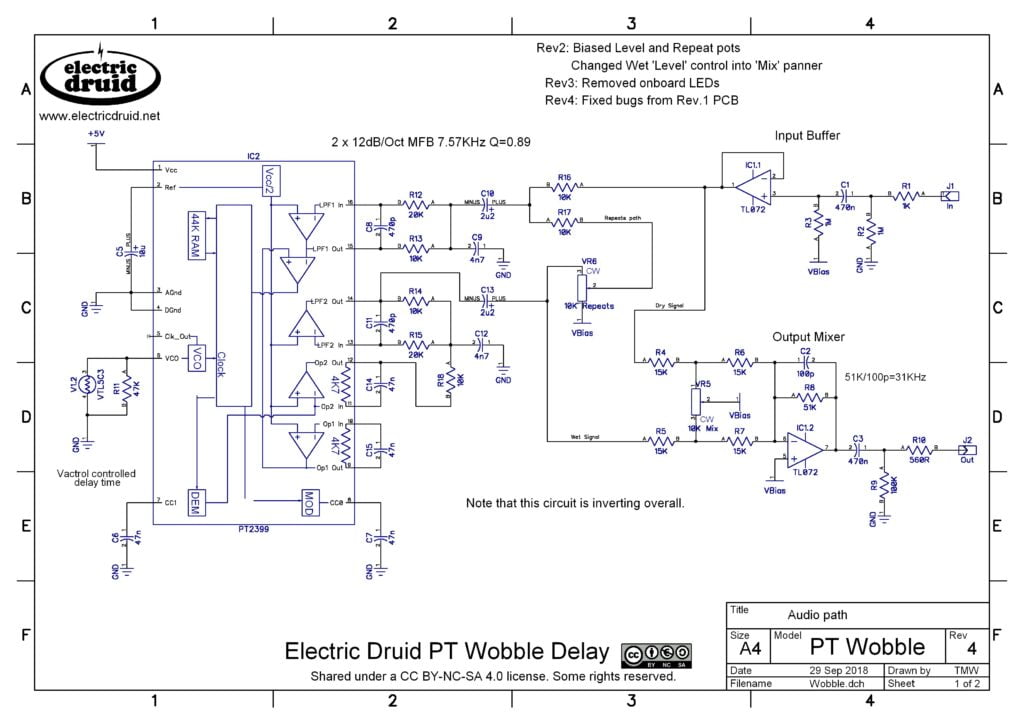I’d like to share a couple of things I’ve had kicking around on my desk for a long while. The first one was a simple optical tremolo, and for this second StompLFO project, we’re going to use the StompLFO to apply modulation to a PT2399 delay. This is actually very simple to do!
PTWobble, StompLFO Modulated Delay
First, let’s start by looking at the audio path:

We start in the top-right with a standard op-amp buffer circuit. Pretty much all my pedals start with one of these. We then move onto the input filtering around pins 16 and 15 of the PT2399, which I’ve modified from the PT2399 datasheet example. It’s still a Multiple Feedback (MFB) filter, but I changed the values using this tool. Once the signal has been through the filter, it stays inside the PT2399 and goes to the delay. After that, we come to the post-delay filtering around pins 13 and 14, and finally back to the outside world at C13. From there, the signal splits, with one path going to the Repeats pot and back to the input filter via R17, while the other path goes to the Wet/Dry output mixer, IC1.2. This is a useful building block circuit since it can be used to crossfade between any two signals using a single pot. I learned about it originally from R.G.Keen’s Panning for Fun article.
The usual 50K “Delay Time” pot on pin 6 of the PT2399 is replaced with a vactrol and a 47K resistor. As we discussed in the Mini Tremolo article, adding a resistor in parallel with the LDR of a vactrol like this allows us to set the maximum effective resistance of the LDR. In this case, we’re limiting it to 47K, because that’s about as long a delay as you can get out of the PT2399 before it becomes totally crunchy. By all means experiment with larger values for R11 if you wish. It’ll get crazy lo-fi.
That’s the audio path, and aside from adding an input buffer and a proper wet/dry mixer, it’s a pretty typical PT2399 circuit. The wild stuff happens when we apply modulation! So let’s look at the StompLFO part of the circuit:

Again, like the Mini Tremolo, we have stompbox-standard power input protection and filtering, and the virtual ground creating a Vbias level, which is essential for single supply op-amp circuits.
For the StompLFO itself, I’ve drawn it much more tricked out than the Mini Tremolo version, but you can mix and match between the two circuits and either simplify this one or add these tricks to the other.
So what’s going on? Well, we’ve got a 10K Delay pot top-right that is connected to a TRS jack socket. This allows you to plug in an expression pedal to replace the delay pot, so you can tweak the delay time with you foot for wild pitch-bending effects. I borrowed this from the FilterFX pedal, where the expression pedal allows you to use the filter like a wah. Since the StompLFO is only concerned with the voltage at pin 2, what value of pot the expression pedal has in it shouldn’t matter too much. Anything from 10K to 100K will be fine, and other things outside that range might work too, but I haven’t tried it. If you don’t want the expression input, just wire the delay pot between 5V and Gnd like the other three and take the wiper direct to pin 2. You don’t need the socket, R27, R28, or C22.
I’ve also shown a connection for a Tap Tempo footswitch J8/Tap. This should be a momentary SPST switch, and the other connection goes to a ground connection somewhere. Note that this is not a tap tempo delay! It’s setting the rate of the LFO, not the delay time. I’ve also shown an optional Sync Input, which would allow you to synchronise the LFO to incoming clock pulses from another bit of gear – a drum machine or sequencer or something.
I haven’t shown the 3PDT wiring on this schematic, but all the connections you need are shown, including power for the Bypass LED and an LFO LED to indicate the rate.
Going further
One thing that might be interesting to experiment with would be adding a second PT2399 for longer delay times (and/or better quality!). You could add another vactrol controlled by TR1 just like the existing one, it won’t blow up the StompLFO. The fact that there’s a drive transistor in this circuit means we’ve got loads of potential current if we need it.
Since both this circuit and the Mini Tremolo use vactrols to control the modulation, any LFO that can drive a vactrol’s LED can be used in place of the StompLFO. That means the TAPLFO3 or VCLFO10 could be used instead, for even more features. Those chips have PWM outputs and don’t need filtering to drive a vactrol, just like the StompLFOs PDM output.
If you build this, let us know what you think of it and how you got on in the comments below. Thanks!
mini tremolo + PT wobble delay in one enclosure = wobbly P tremolay!